The vast inland sea known as the Western Interior Seaway of the Late Cretaceous split the continent that we would come to know today as North America from north to south. As the landmasses on either side were ruled by dinosaurs and other terrestrial animals, this inland sea was ruled by huge marine reptiles. While the turquoise surface looks calm and inviting, just beneath its waves, huge shadowy figures come up from the depths. This is the realm of the Mosasaurs and one of the largest, Tylosaurus, patrolled the shallows in search of its next meal.
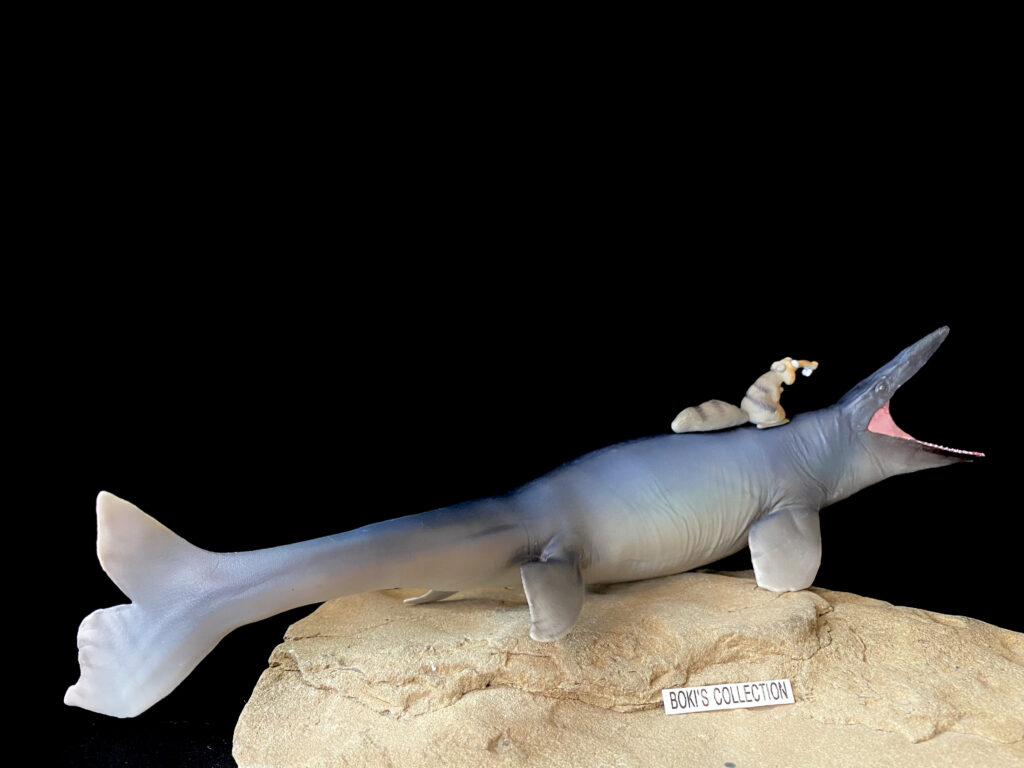
Although it hasn’t reached the same level of popularity and name recognition as its relative the Mosasaurus, Tylosaurus has maintained a pretty consistent presence in both popular culture as well as in the toy model world in the last decade.We have several mixed bag of toy figures of it out circulating the market, some like those from Procon and Papo leave so much to be desired, while the Safari Carnegie reigned as the best for many years and just now faced serious challenge to that title with this PNSO model.
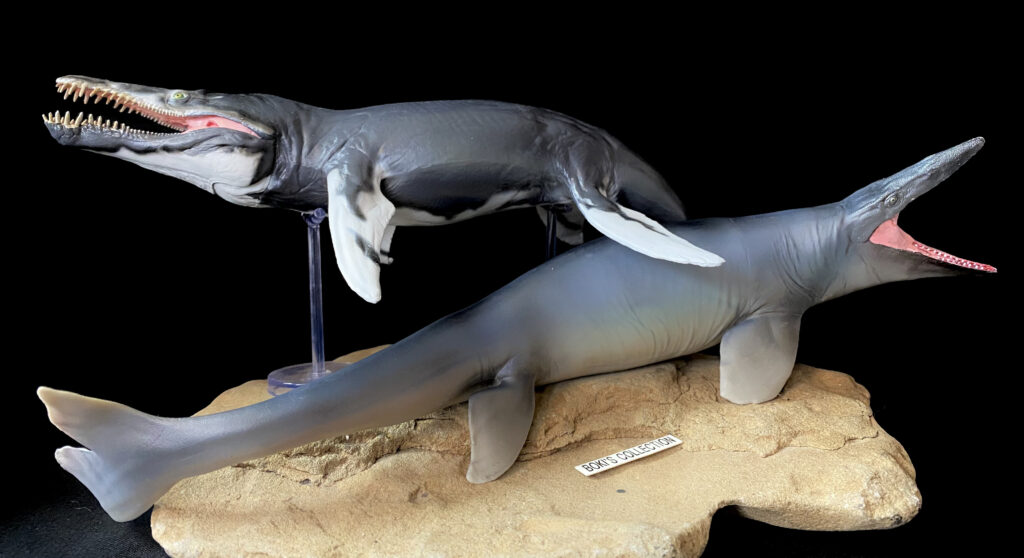
Tylosaurus was one of the largest mosasuar and also one of the last. As the giant pliosaurs that once dominated the seas slowly vanished and eventually going extinct, the mosasaurs quickly radiated and diversified to fill in those newly vacated niches until they were the top predators of the oceans worldwide.They also grew large and would soon rival some of their pliosaur predecessors in size by the Late Cretaceous with some estimates giving a size range between 39-52″feet long!
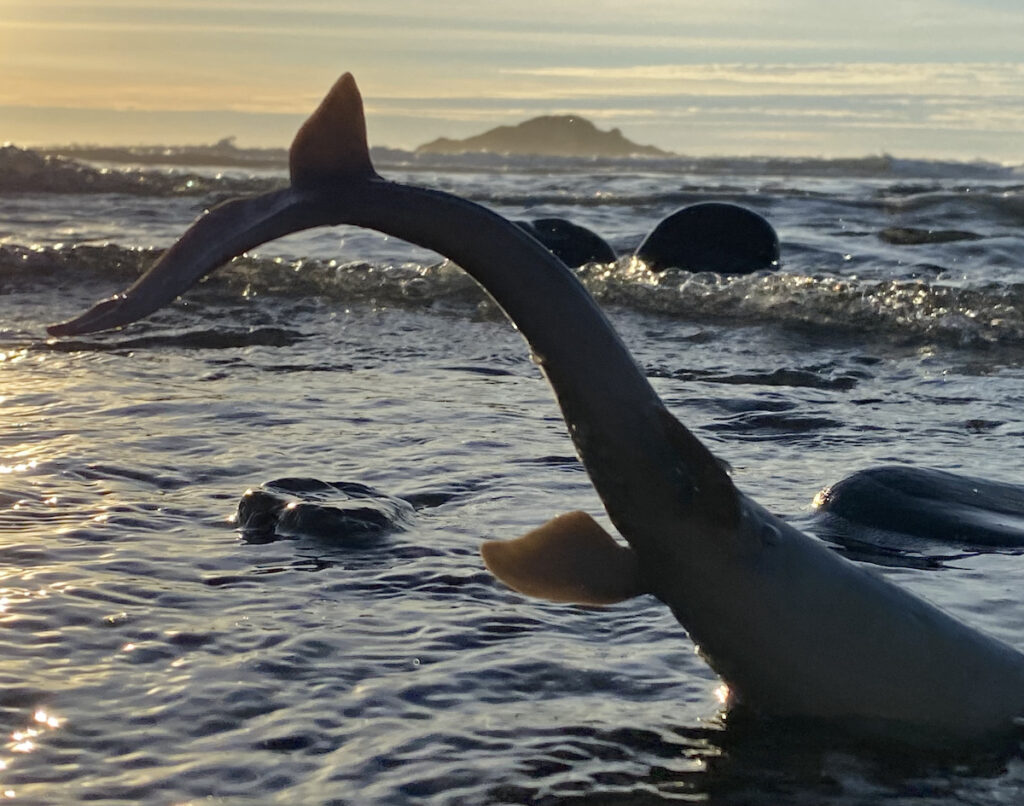
After a long parade of dinosaurs, PNSO took a break and shifted focused to marine reptiles and other denizen of sea, to the delight of collectors and marine reptile enthusiast. With Tylosaurus’s popularity, it wasn’t a surprise that PNSO would release a figure of this giant right after their Kronosaurus.In fact, we had a preview of the figure when PNSO launched their revamp Amazon store page and right on the Museum Marine section banner we saw the unmistakable silhouette of the Tylosaurus head.
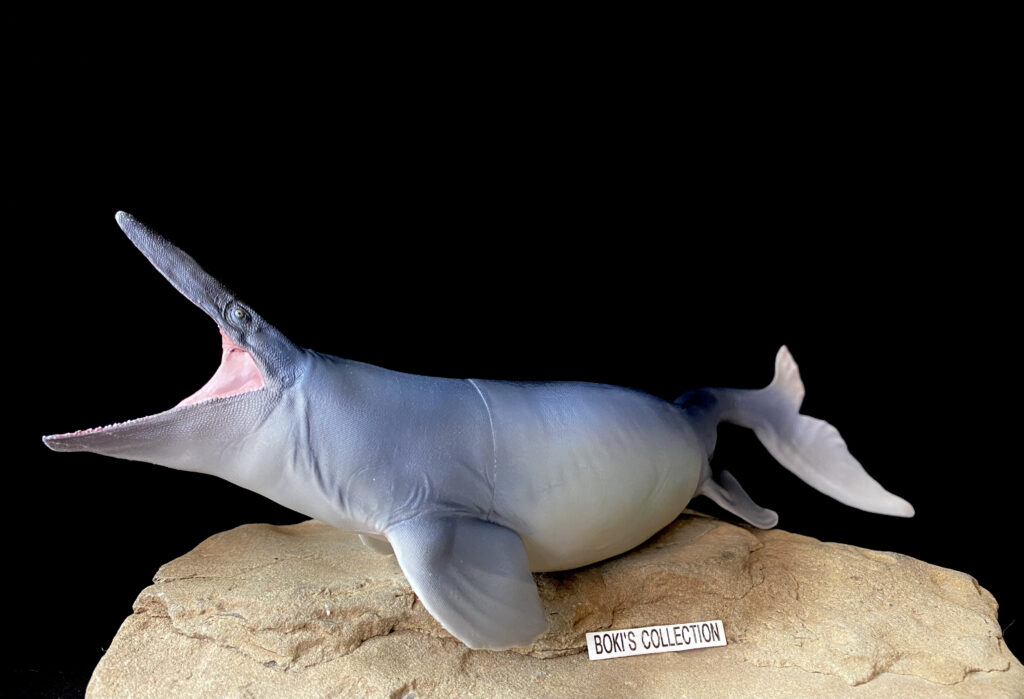
PNSO is known for their beautifully sculpted dinosaur models and its exciting to see that it translated to other prehistoric animals and this Tylosaurus is no exception. From the promo images, we see a dynamic model with many unique features that makes it stands out from all others. Unfortunately, the decision to make the model hollow comes with an inevitable consequence: visible seam line. We may never know what prompted PNSO to decide to make this (and the rest of the marine animals that would follow) model hollow instead of one solid. We will get back to the seam lines in a bit as this is the one major point of almost universal criticism that the model received.
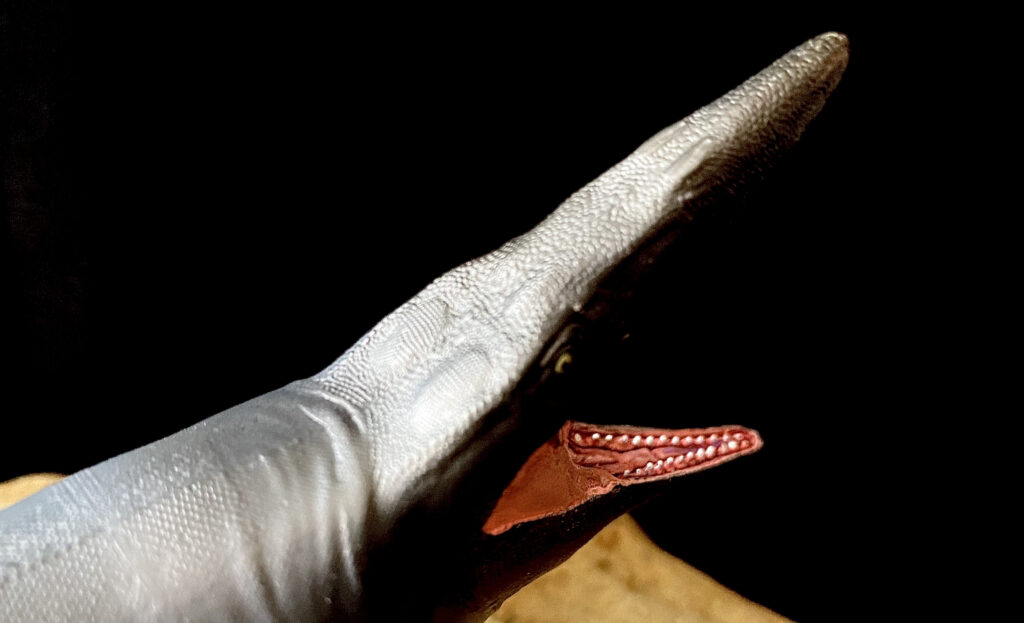
One of the most distinguishing characteristics of Tylosaurus is that it had a long and pointed snout when compared to other Mosasaurs. At the tip is a bony protuberance that scientist believed the animal used for combat and hunting by ramming it against rivals or prey.PNSO beautifully replicated this unique characteristic on the model as expected.
The head is delicately sculpted with an amazing number of details that are not immediately noticed especially from a short distance.The scales on the head and jaw are slightly larger than those seen on the body, but they are so delicate and subtle that you need to have it in hand to fully appreciate the intricate way each scale is sculpted.
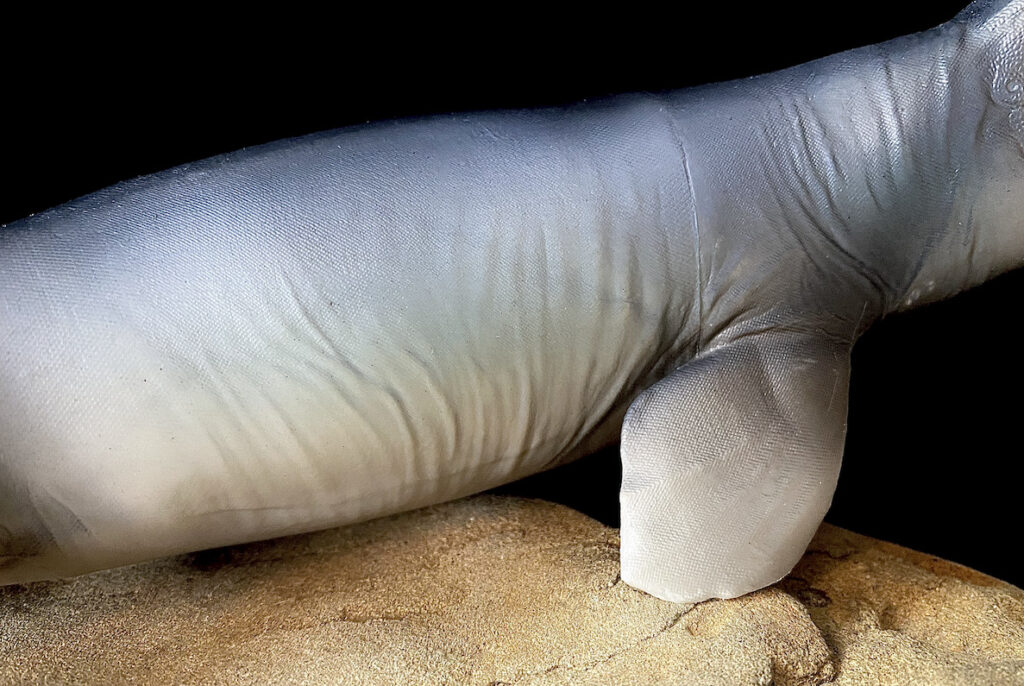
Skin impressions from Tylosaurus are known and they are small and diamond-shaped that are arranged in oblique rows very much like that of snakes. As large as these animals are, the scales covering their bodies are small in proportion to their size. PNSO did an amazing job in sculpting the scales on the model; there are no oversized scales here. So subtle are these scales that at first glance the figure may look smooth, but look closer and you will see the very delicate and small scales covering the entire body all the way down to the tail. It really is impressive how beautifully the scales are rendered.
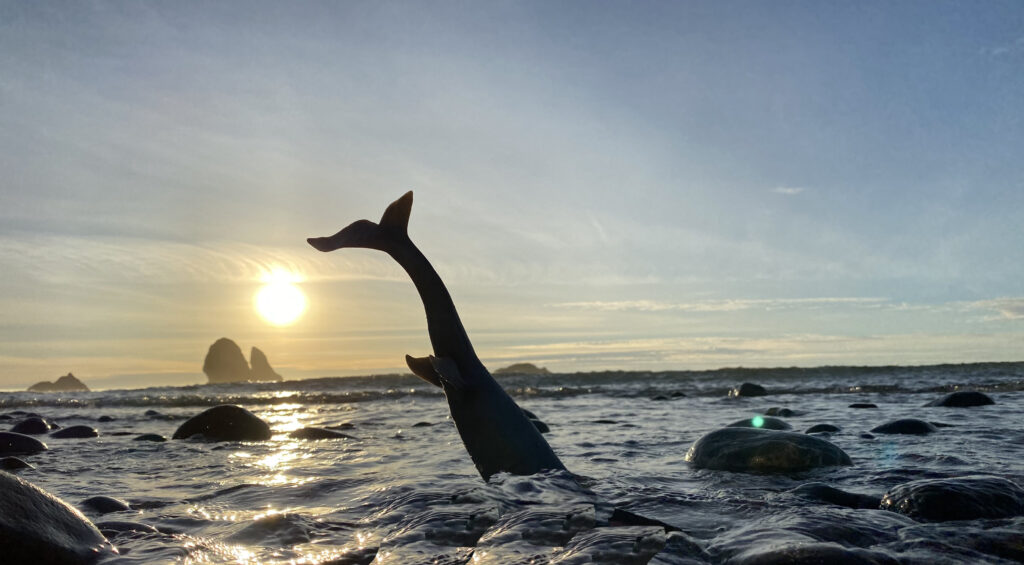
The eyes are ringed with skin folds and cresses and is colored muddy-yellow with a black pupil. Unlike the Kronosaurus, the jaw is not articulate and is sculpted wide open. There appears to be some type of lip so the teeth are not fully visible from the side but can be fully appreciated when you look inside. These upper and lower rows of teeth, as well as those on the palate are individually sculpted and cleanly painted, at least on my copy.

Unlike other Tylosaurus (and mosasaurs in general)models, this figure is given a slender tongue that terminates into a forked tip (many believe that they have forked tongue), something you don’t see often. The flesh inside the mouth is life-like in color as well as the detailing. You can also clearly see the ears way back.
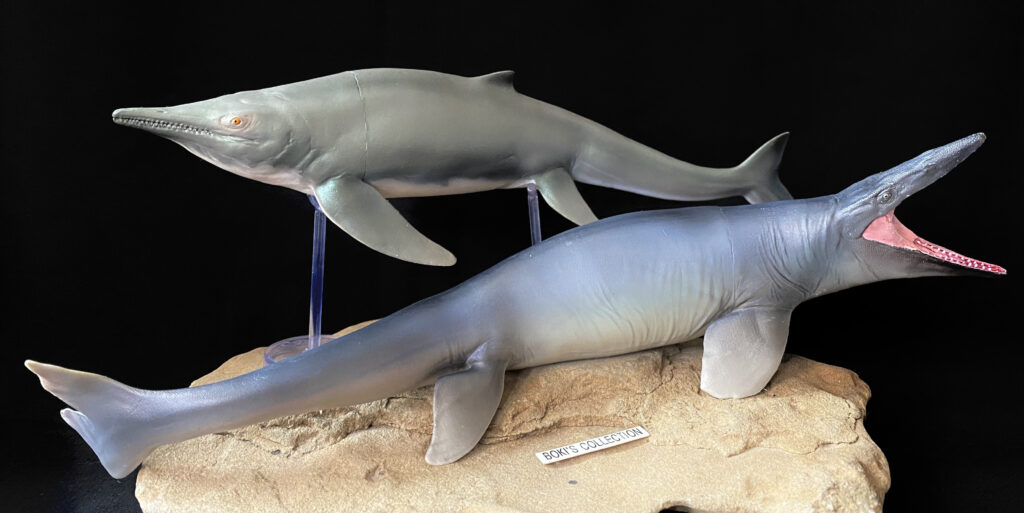
Unlike the Pliosaurs and ichthyosaurs, mosasaur’s paddles are shorter and more rounded than pointed and you see that beautifully captured in this model. The base is thick and muscular as they should be, you can see the faint outlines of the paddle bones as well. The paddles are robust with lots of meat to them which is nice, we often see paddles that are so thin and shrink-wrapped. There are muscle outlines and skin folds on the paddles that suggest tension or resistance as the they move about.
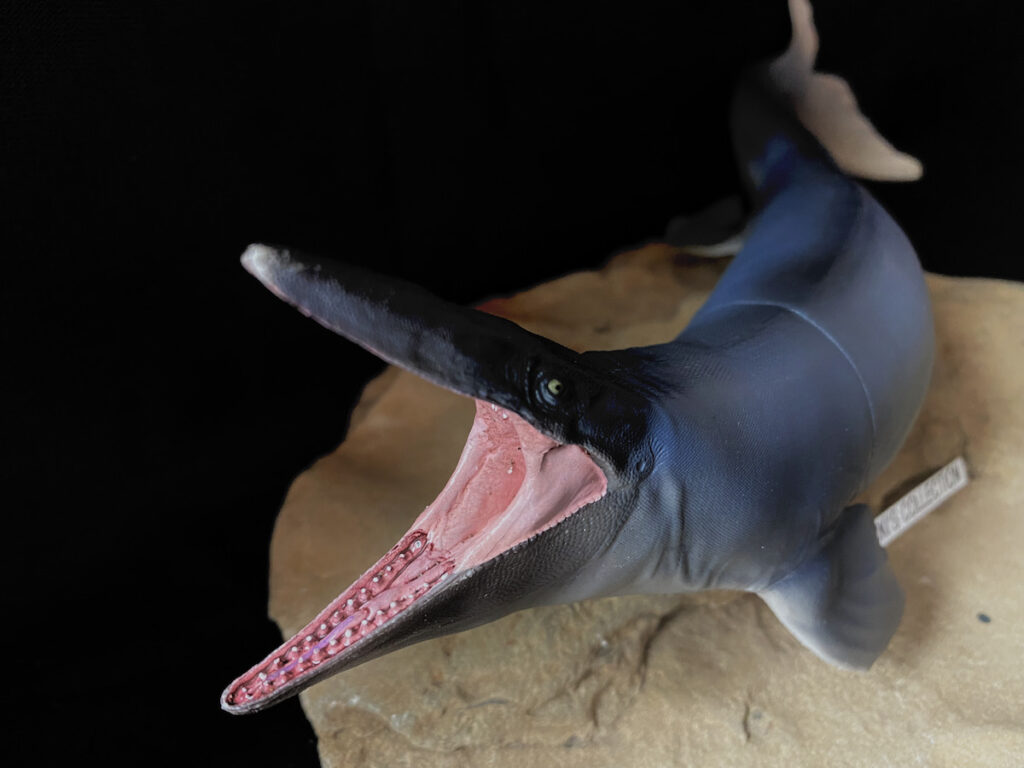
The neck is short but powerful as it should be and we see plenty of skin folds on the areas we expect to see them like just behind the head and at the base of the paddles. As you move down the body, you see more skin folds on the sides and stomach region, and there is even some subtle outline of the ribs that can be seen. One thing is for sure, this animal is well fed and you can appreciate that by looking at just how nicely filled out it is. Also, worth noting that unlike their Mosasaur, PNSO did not give the Tylosaur a speculative dorsal fin.
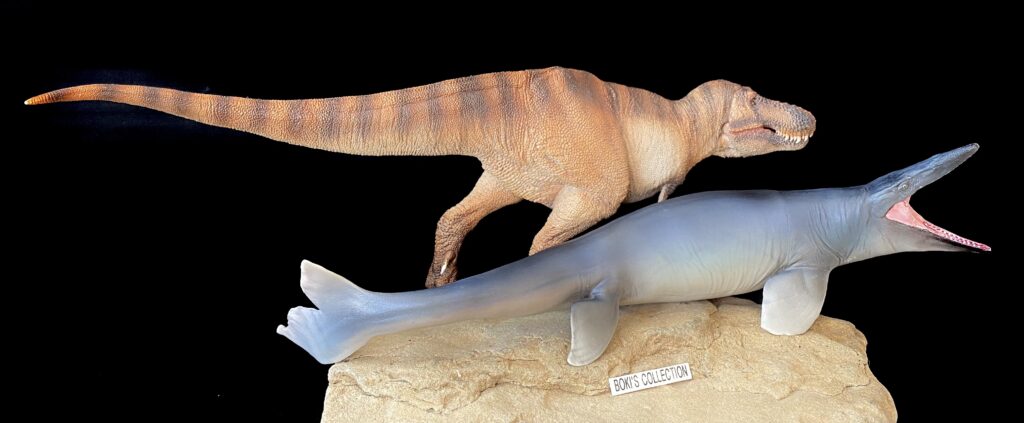
Now, remember the seam line? For some reason, on hollow figures, the seam lines tend to be always located in the neck or middle of the body area, the two most visible part of the body.In this model the seam line is located just after the front paddles. When I first started seeing on hand photos of the model, I was concerned that these lines would look really visible.
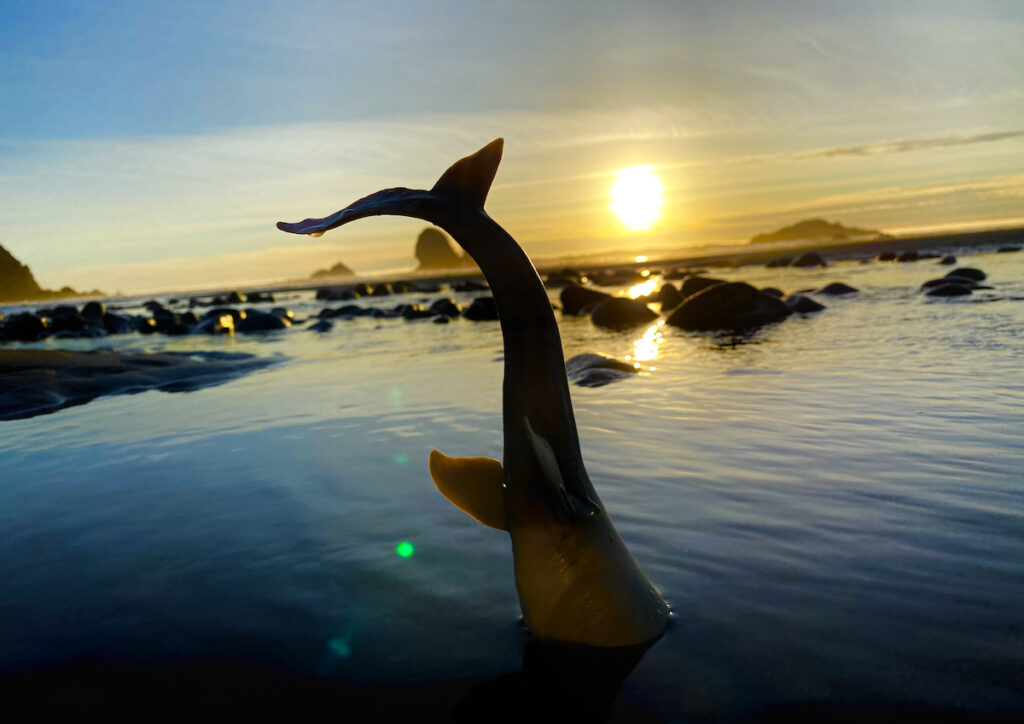
Having the model now, yes, the seam line is visible but not as bad as I have originally thought it would be. From a short distance you can hardly notice the line and there are certain angles as well where the line is barely visible. In photographs it looks much more prominent due to the close distance between the model and camera so keep that in mind.It is inevitable for hollow figures to have seam lines, I guess it’s just part of how the parts are attached during production. In the end, I don’t have a problem with these lines and have learned to accept it.
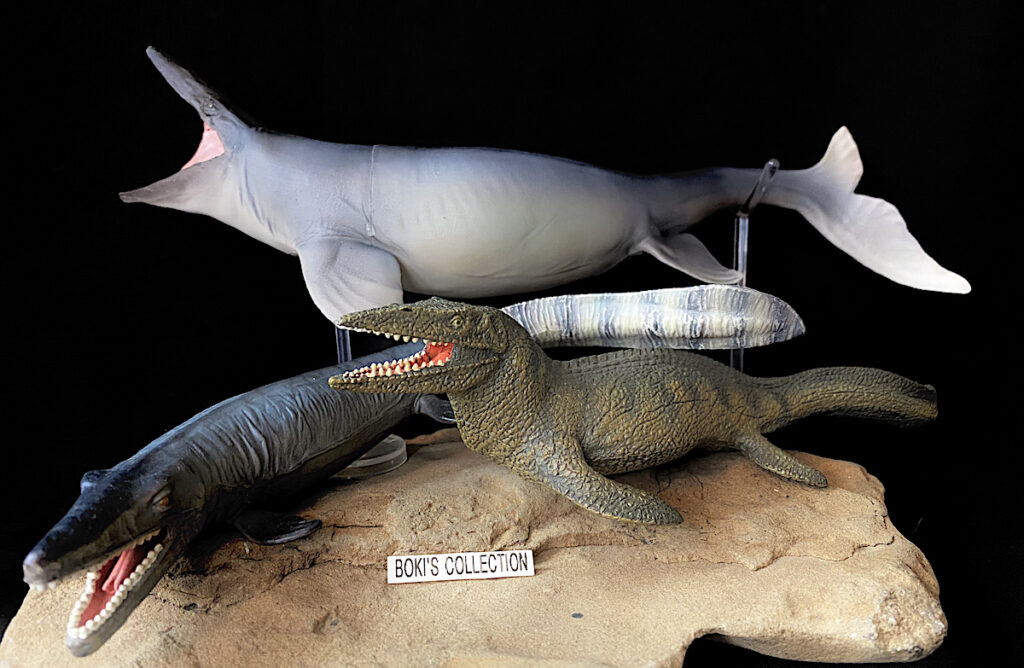
At 13″ inches long (including the curvature) the model can be considered 1:35 scale (as advertised) based on 43′ feet long individual. It is posed in an active way (as active as can be given the limitations) as if the animal is about to bite its prey or rival.The tail has a nice curvature to it that suggest movement. The pose is also flexible in that you can orient it either vertical as if it is swimming upwards, horizontal as it swims close to the surface, or head down as if it’s about to dive after some tasty morsel.
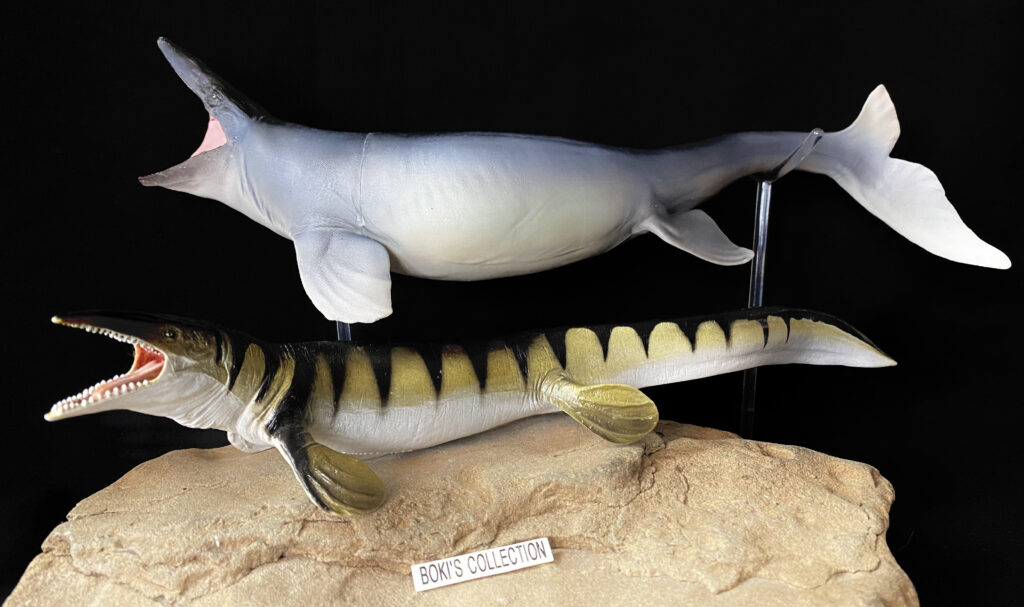
The tail is long, rounded, and muscular as it should be and convey the power it has in propelling the animal as it swims. There are some muscle bulges along the sides especially at the base that adds another layer of realism. When it comes to tail fin, we often see Mosasaurs having a flattened eel-like tail with fins running along the upper and lower sides of the tail like a tadpole’s. More recently, we see the tail change to more streamlined lacking these fin ridges, more robust and rounded instead of flattened, and finally at the tip a fish-like tail.
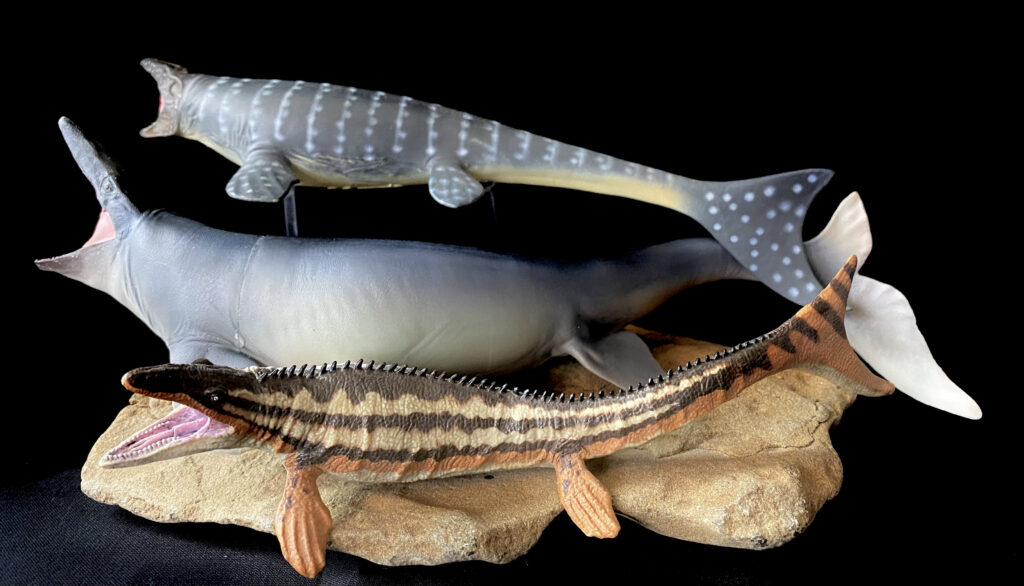
Part of the reason for the change in how the tail is restored is that we now have more understanding of how the animals moved and propelled themselves in the water. In the past the long body and tail of Mosasaurs was interpreted as anguilliform swimmer (moved their entire body), moving their entire body by undulating like a snake. These days with more study it is now understood that the upper part of their body is not as flexible as once believed and that it is more rigid which left most of the power to propel concentrated at the base of their tail. And some fossil of other Mosasaurs did have tail fluke impressions which cemented the new look of the tail as having more of a fish look than a salamander.
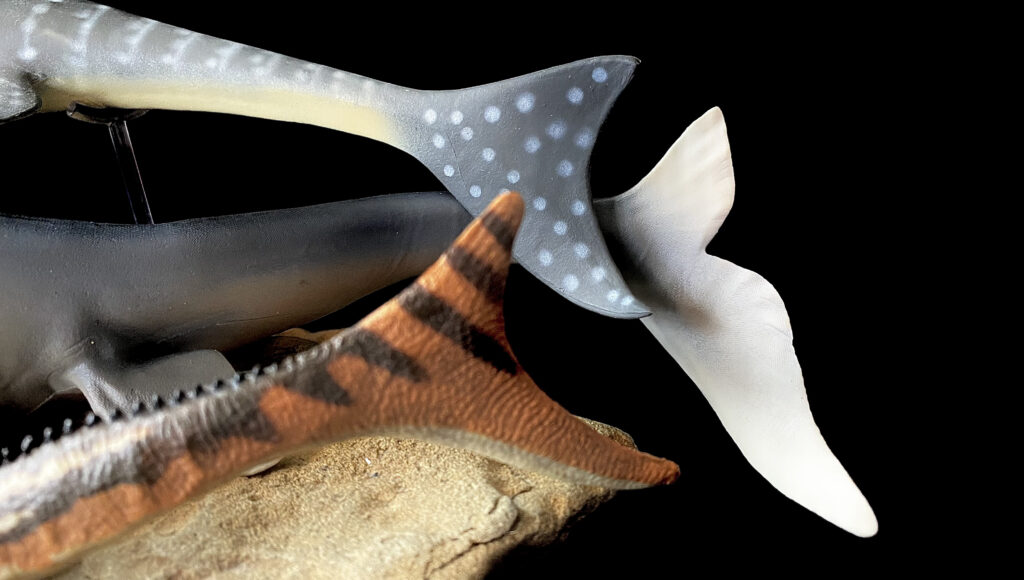
Not since CollectA’s and Favorite, as well as PNSO’s very own Mosasaur models have we seen a tail fin as large and impressive as what we see in this model. The tail fin spreads out like a big fan; the upper lobe is smaller while the lower is longer and wider. There is a deep notch or fork midway where the two lobes separate. It is an impressive and powerful looking tail with no shortage of subtle details. While the tail fin/fluke of Tylosaurus itself is not known, there are however tail impressions from other Mosasaur species that shows a deep forked tail so this is where PNSO based this model’s design.
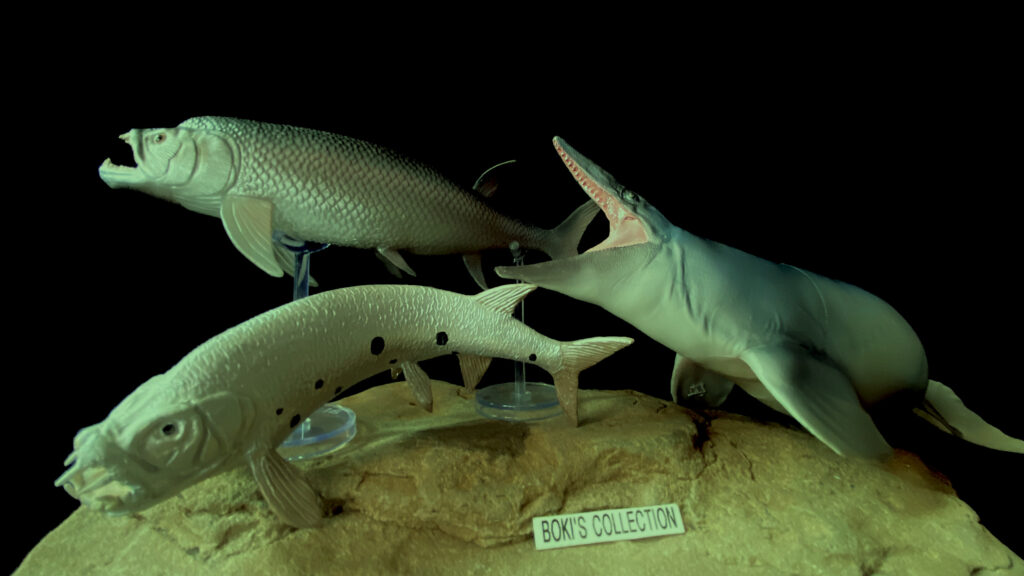
The colors used may seem (once again) drab and simple at first glance especially if you saw some of the colorful artworks that accompanied the promo and inside the booklet.But like many of the simpler color scheme we see on some PNSO models, there is more to this than meets the eyes.The base color is some kind of a dark slate/gray blue that is hard to describe. The figure is given a counter shaded color scheme appropriate for a large seagoing animal and this bluish-gray color runs along the upper half of the model. The bluish shade changes in its intensity depending on the lighting source so its fun to move it around and watch the colors change.There are some evidences that suggest Tylosaurus colors are dark like something we see in today’s leatherback turtles so this choice is appropriate.
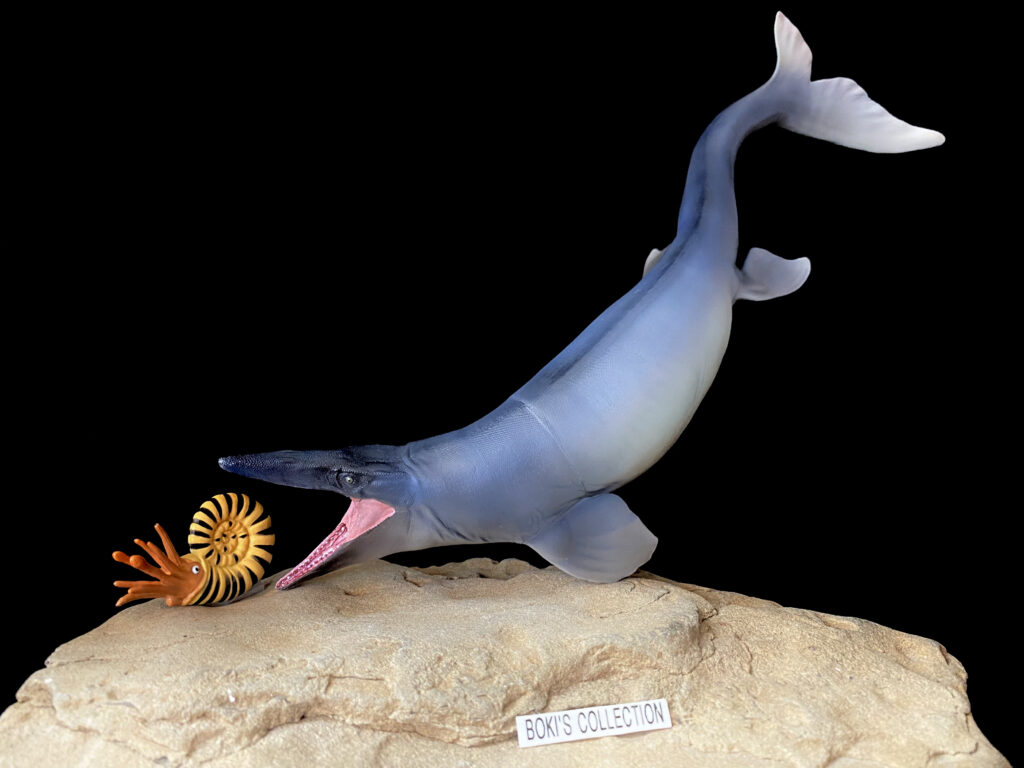
The lighter color that covers the lower half of the body is a mixture of white, light brown, and some yellow tint that are mixed together to form a warm pleasing natural color.This light color blends and transitions with the darker tones above in a subtle and beautiful way; there are no hard edges between the light and dark colors.There is also a light icy-blue highlight around the middle part of the body that plays with the lighting source as you move the model around; not exactly iridescent, but something very similar in effect that is very pleasing. It is worth noting that the colors on the figure helped obscure the seam line especially from a short distance.

Tylosaurus was an apex predator that ruled the Cretaceous seas and was one of the largest carnivores of its time. They hunted and ate a wide variety of other marine animals that included other mosasaurs, plesiosaurs, turtles, birds, fish, and sharks. Bite marks on ammonites suggest that they also fed on these hard-shelled animals as well as squids.There are several models of other marine animals that coexisted alongside Tylosaurus available from other brands as well as from PNSO making it possible to create a stunning display featuring the impressive marine fauna assemblage of the Western Interior Seaway.
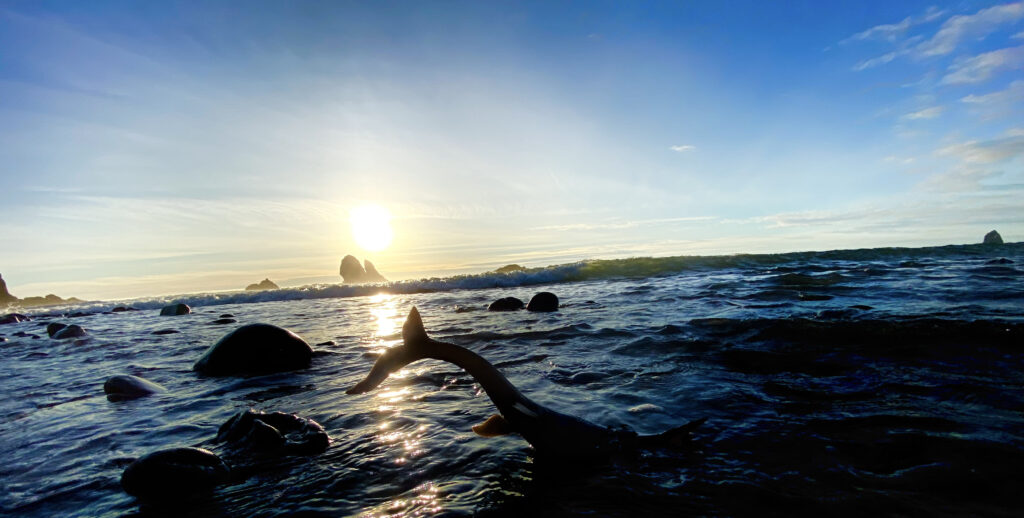
In closing, this Tylosaurus model from PNSO is a welcome addition that brings a breath of contemporary or modern look that is perfect for our time. The visible seams aside, which is not bad at all, the figure has so much new to offer that brings excitement to a genus that has often fallen short despite being produced by various brands consistently over the years.For me, this is the definitive Tylosaurus model in my collection, one that I have been waiting for to spice up that marine reptile shelf.
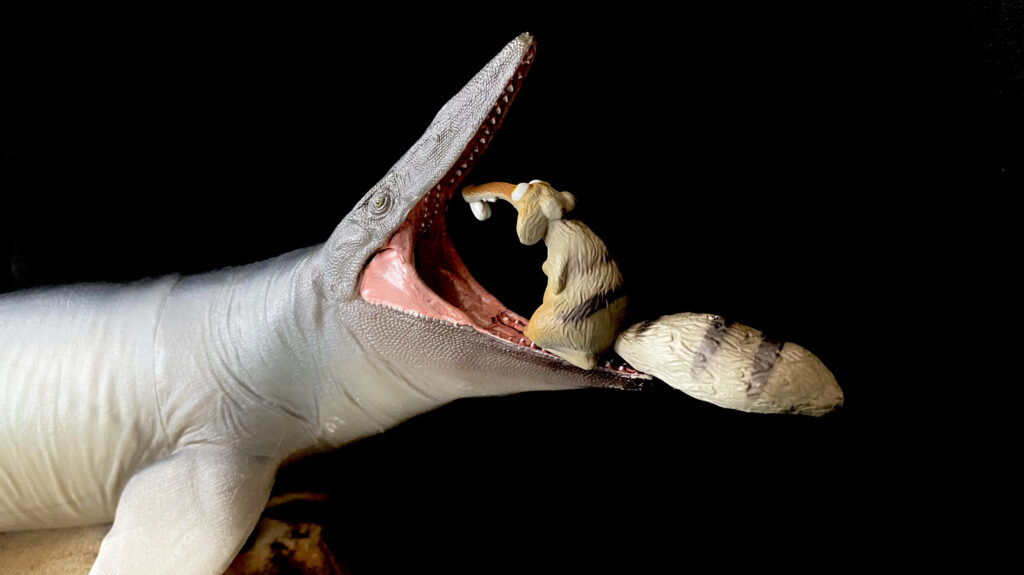
Hope you enjoyed the review! Until the next one, stay safe and healthy.Cheers!
Disclaimer: links to Ebay and Amazon on the DinoToyBlog are affiliate links, so we make a small commission if you use them. Thanks for supporting us!





I love the Picture with the Xiphactinus´!
It´s very Realistic looking!
I pretty much read all the reviews including those that really don’t interest me. However your reviews are on figures that interest me, so i always look to see what you have to say.
I really wasn’t that into PNSO’s marine reptiles initially but I’m coming around. Once you accept their flaws they’re otherwise really nice pieces. This is the best Tylosaurus, aesthetically, since the Carnegie. Great review and photographs, as always.
Great review as always. I have to say, out of all the mosasaur toys in existence, the Carnegie Tylosaurus still has the best colour scheme.
Undoubtedly, this PNSO tylosaurus, like many other dinosaurs and in this case prehistoric animals of this brand, are the best of the species made to date from a scientific point of view. Leave others of the same brand in the background. Magnificent article like all those that Bokisaurus does, his analysis of the product detailing said toy and his scientific and historical data are always welcome in the DTF and in this case in the articles to which we are accustomed.
How come you didn’t show the Fauna Cast Tylosaurus? Do you have any pictures of your Marine Shelf?
Hi Stoneage! I didn’t know you read my reviews! I actually took a couple of photos of the model with the fauna cast and had included them in the original draft.
But I decided to take them out on the final edit for two reasons: 1. Unless it’s the only figure in my collection, I tend to not do a comparison between pvc and resin models since I feel they are two separate categories.
2. I wanted to compare the model with figures that were comparable and that most collectors may have, and also figures that are easily obtainable.
But I’m going to post them in one of my thread, maybe the BTS one so keep an eye out if you want to see them together.
Thanks for stopping by.
Thank you, you are always so kind. Glad you enjoy my reviews, that’s the greatest compliment.
Starting and ending the review with shots of Scrat nonchalantly hanging out with this giant angry-looking predator tickled me more than usual. The seaside photos look great, too!
Haha, glad you got a chuckle out of them! I just realized it’s Ben 3 years since Scrat’s been a fixture on my reviews.